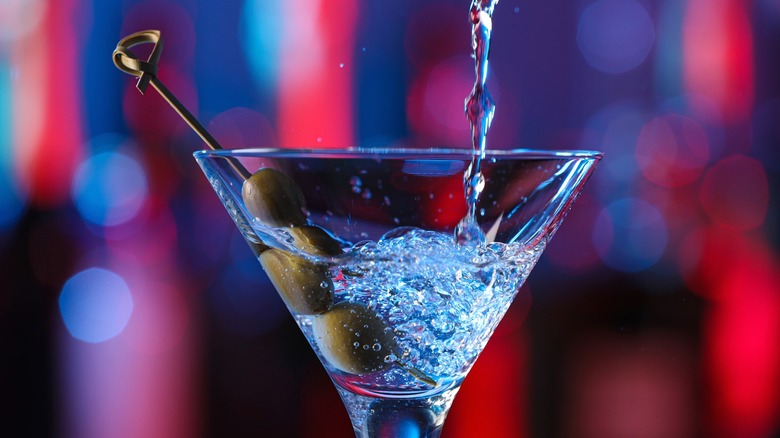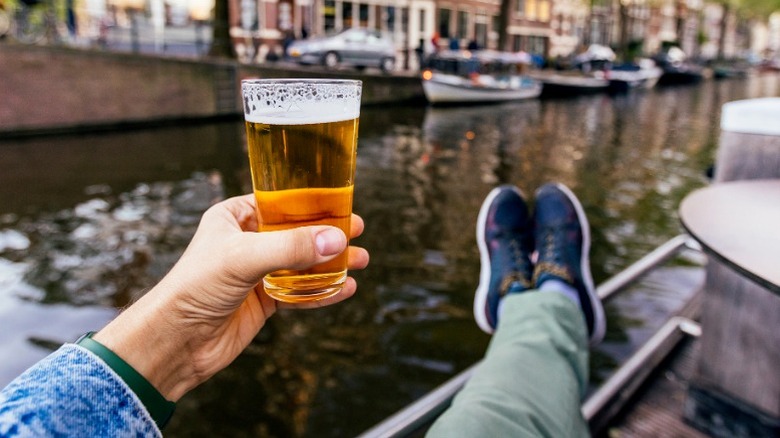How Long Does It Really Take For Alcohol To Take Effect?
No two drinkers are exactly alike. One person might only need a White Claw to start feeling a buzz, while it could take a few Jell-O shots for someone else to get on the same wavelength. Many factors determine how our bodies process alcohol, and understanding these mechanisms can help you make more informed decisions as you enjoy adult beverages. To walk you through the science, Chowhound reached out to an expert.
"Alcohol generally begins to affect the body within 30 minutes to two hours after it is first consumed," says Lena Bakovic, MS, RDN, CNSC at Live It Up. "The time frames can vary on several different factors such as individual speed of consumption, body weight, and one's metabolic rate."
Of course, high-proof distilled spirits hit harder than a single beer, but even the most fundamental non-alcoholic cocktail components can influence how drinks affect your system. For instance, caffeinated cocktail mixers, like Redbull or the coffee in an espresso martini, "mask" the depressant effects of alcohol, leading some people to feel less intoxicated and drink past their limit. Bakovic shares that carbonated mixers like seltzer, club soda, and tonic water tend to speed up absorption, whereas non-carbonated ones may slow it down slightly. She also notes that sugary mixers can further affect absorption, delaying alcohol's effects due to their calorie content, and that sugar may impact other bodily functions as well.
Don't forget to eat and stay hydrated
The rate at which you'll feel the alcohol in your system depends not only on what you're drinking but also on what you're eating beforehand. Alcohol's journey throughout the body starts with the stomach, which is why drinking on an empty stomach can lead you to feeling intoxicated much quicker than you would after eating a proper meal.
"Consuming alcohol on an empty stomach can for sure result in faster absorption and quicker effects," says Lena Bakovic. "In contrast, a full stomach — especially one containing ingested dietary fat — can actually slow down absorption because the fat delays alcohol from reaching the small intestine, where most absorption takes place."
Only around 20% of the alcohol is processed in the stomach, while the majority is absorbed by the small intestine into the bloodstream. Eating food and drinking water set your body up for success by keeping you hydrated and potentially alleviating hangover symptoms, but not even a Liquid I.V. can cure intoxication. Water can't "flush out" all the alcohol from your body, and food only helps slow its journey to the bloodstream. It's up to the liver to take care of alcohol in the bloodstream.
Give your liver time to process each drink
As Lena Bakovic points out, alcohol is typically processed in the liver at a relatively steady rate of approximately one standard drink per hour, though this varies from person to person. She says, "People commonly start to feel the effects of alcohol, including the feelings of intoxication, while it remains in their bloodstream. The presence of fatigue and dehydration may also contribute a feeling of [intoxication], even after blood alcohol levels start to decline."
The liver is a crucial organ for filtering toxins in the bloodstream and converting nutrients into energy — there's nothing you can do to expedite this process significantly. "The most important factor in reducing intoxication from alcohol is time, as the liver, over time, slowly metabolizes it," Bakovic says. Variables such as body size, age, hormones, genetics, and pharmaceuticals all play a role. (People often overlook how prescription and even over-the-counter medications like ibuprofen and acetaminophen, which can negatively impact the stomach and liver, interact with alcohol, so check with a doctor or pharmacist for safety.)
Feeling drunk, being drunk, and meeting the legal definitions of being drunk (a blood alcohol level of 0.08% or above) aren't always the same thing. Cocktails and other drinks can give you a buzz, but it can be difficult to predict how much is in your bloodstream. You can play it safe by pacing yourself with a limit of "one standard drink" per hour, as defined by the National Institute on Alcohol Abuse and Alcoholism (NIAAA) guidelines.


